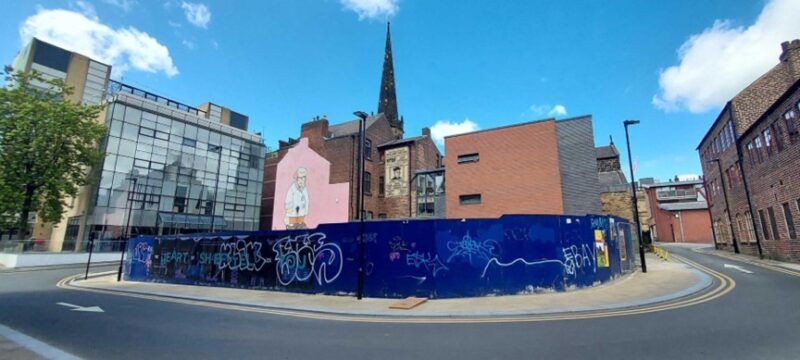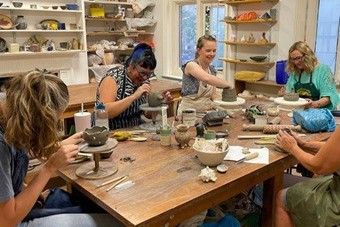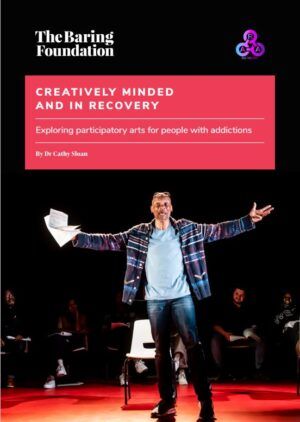Father Ommanney, ‘People’s Priest’ and artist
In 1882, Father Ommanney became the vicar of St Matthew’s church. Residing above the local pub, he soon made a huge impression on the city of Sheffield by championing the poor, battling for sewage and drainage in the slums, building a new church and vicarage using local artisans, as well as designing the stained-glass windows himself.

Alongside this work he also set up a charity that was run in the outbuildings of the vicarage; he provided hot food and taught the local community how to make shoes for themselves, enabling people to go out and get work.
Fast forward 115 years or so, and in the same buildings a group of local artists were delivering art and pottery courses for people living with mental health conditions, still in the original outbuildings. In 2012, they put in a successful bid with the European Regional Development Fund for £1.1m to demolish the outbuildings, create a new building and take on the vicarage as a new arts hub to provide wellbeing and commercial courses with a Café and Gallery. This opened in 2016.
By March 2022, however, when I took over as Strategic Director, the charity had accrued significant debts from the renovation and the pandemic had also taken its toll.
The new approach we settled on was to increase the commercial courses, introduce workshops, reassign roles within the staff to reduce the weighting of management, and secure funding for two wellbeing groups. The pottery department would be left as it was at this stage as it had a consistent income stream.
We wanted to move away from famine and feast, build a model and recognisable brand that everyone could be proud of, and a route towards being a self-sustaining charity not reliant on grant or public funding. A new three-year plan aimed to give the charity a cashflow that could cope with its monthly obligations, and the ability to grow into a profit-making organisation.
Developing the commercial offer
Conversations began with our commercial end users (pottery studio members, art class attendees) to see how we could provide for their needs and be able to grow. Our demographics are 89% female, semi-retired or retired within the day and around 50/50 male to female on an evening with 77% being in employment. What did they want from The Art House; how could we provide it?
The pottery department has a membership scheme which gives its members a certain amount of studio time per month for a subscription fee. At this point it had 60 members. We needed to ensure what we provided met their need and allowed us to grow this important source of passive income.
A lot of time was put in with the pottery department on timetabling and we developed a proposal on how to change the use of the rooms to make the space easier to use and so we could provide other opportunities and deliver multiple courses at the same time.
A more structured journey for people coming to learn pottery was developed: Half-Day Workshops for Throwing on the Wheel; Half-Day Workshops for Hand Building: Six-Week Pottery Course; and Become a Member.
Our Art department started to expand by providing extra courses or workshops for the popular classes. In other words, we would provide what people wanted: now we only offer watercolour, how to paint, how to paint with oils, and a self-development group; however, the number of groups has increased.
Staying true to the founding vision
It was important to keep Father Ommaney’s vision to support people within the community who are struggling with their mental health with the pottery and art-based wellbeing groups. We wanted this aspect to be consistent and sustainable and not dependent on any grant that the charity could get. It needed to be central to The Art House ethos, enabling and constant.
 The pottery studio had always had a grant-funded Monday morning Wellbeing Group. We decided to keep this and fully fund it ourselves. Throughout the week we would work and collaborate with other like-minded charities and then book-end this on a Friday with a new in-house Wellbeing Group that we would get funding for.
The pottery studio had always had a grant-funded Monday morning Wellbeing Group. We decided to keep this and fully fund it ourselves. Throughout the week we would work and collaborate with other like-minded charities and then book-end this on a Friday with a new in-house Wellbeing Group that we would get funding for.
Our founding church, St Matthew’s, also has another charity project called The Carver Street Parish Nurse Project. They work on the streets with the homeless of the city, helping people to get support for their addictions, re-homed and in some cases had some clients come to volunteer for them. We started discussions with them to see what we could do together.
Through them, I met Mr Anderson and Mr Green both who had been through this process and were on their journey from addiction. Subsequently, we withdrew our contract with an external cleaning company and employed them as our cleaners / maintenance and we discussed what they felt we could provide them with, as lived experience staff.
Together we designed ‘The Anderson-Green Project’ which would give people like them a safe space on a Friday evening where (as Father Ommanney did) we would provide hot food and new skills in cooking, pottery and art workshops, and supported by The Carver Street Parish Nurses.
As this project was specific to the city of Sheffield, we could access grant funding via Sheffield City Council and South Yorkshire Housing Association, including for a brand-new kitchen and café area for the use or funding of our Wellbeing groups only, and funding to run The Anderson-Green project over an 18-month period.
The kitchen café has become a rentable space for commercial use as well as for Sheffield Young Carers, Open Up, and two government schemes to teach young people how to cook.
A platform for artists
Our gallery, which had been showing mainly local artists, was programmed to start with bigger national and international artists, then work on a split of 70/30 local to national. This gave us new audiences, a voice in the city and the ability to advertise what we offer through free interviews with media. It also gave us a lot of stunning visuals quickly as each exhibition only lasted four weeks.
Part of the café area was made into a more formal gallery space, and a collaboration with ‘Open Up Sheffield’ was formed which gave them the programming of the space on a yearly contract for local artisans. This gave us a different audience, access to opportunities to network, and a space that released some capacity within our staff as another organisation managed it.
Where are we now
We set a target of a £1 operational profit and ended up at over £7,000 operational profit in the last financial year. And over the past three years under the new model of development and delivery we have reduced the charity’s debt by £106,915.
Google search had moved from 96% looking for ‘Pottery or Art Class Sheffield’ to 89% searching for ‘The Art House Sheffield’.
We have grown the pottery membership from 60 to 161 members, which we hope to increase to 200.
We are now looking at becoming operationally smoother with a more professional administration and legal structure to operate the charity within.
Find out more about us:
